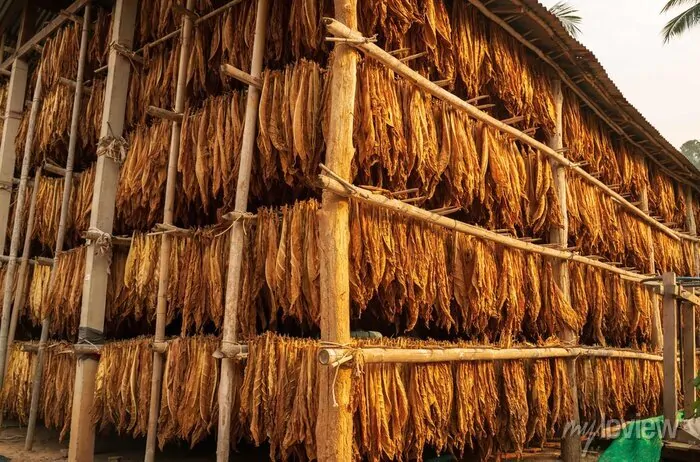The selection of the first Burley bushes is credited to George Webb and Joseph Fore and dates back to 1864.
Globally, Burley tobacco bushes can be divided into light (this includes the so-called White Burley) and dark varieties. The leaves of dark Burley are literally soaked in nicotine and have a higher tar content. They produce a “heavy” earthy, animalic flavor that we often recognize as cigar-like.
Light varieties, White Burley have a moderate amount of nicotine and such tobacco is characterized by a nutty flavor (fresh or roasted walnuts), sometimes the taste of light Burley varieties brings associations with the taste of cocoa.
If we talk about processing technologies of harvested Burley tobacco leaves, this tobacco is often subjected not to a single processing procedure, as it happens in most cases with Virginia leaves, but to a whole cycle of different treatments.
Most often the first number one is air drying of tobacco leaves – tobacco is hung in a barn, where under the influence of circulating air the leaves dry to the required degree, changing their color. This procedure takes eight weeks or longer, depending on humidity and other climatic conditions.
Dark Burley, known as Dark-Fired Kentucky or simply Kentucky, instead of air-drying, is dried over an open fire so that the tobacco leaves are both roasted and smoked. This method is similar in many ways to the Oriental tobacco known as Latakia.
Burley is somewhat of a competitor to Virginia, if I may say so, it is also versatile, although the nature of the versatility of these tobacco varieties varies considerably.
There are practically no limits to the use of burley in today’s tobacco production. It is used in cigarette production, cigar rolling, and in the creation of tobacco mixtures for smoking pipes. Burley’s snuff and chewing tobacco production has not been spared either. In short, all the production of any tobacco products in the modern world use either Burley itself in its pure form, or its “derivatives”.
Perhaps due to the fact that at some point in time the word “Burley” became virtually synonymous with “flavored tobacco” and led to the fact that many pipe smokers (usually fans of “pure” tobacco blends) began to look down on Burley. But don’t be too quick to write Burley off. This variety of tobacco perfectly fulfills its role on both sides of the barricades – both in the camp of fans of “aromatics” and in the locations of the regular army of admirers of “clean” tobacco blends.
Light and “medium” varieties of Burley, those with a nutty flavor, are widely used in the creation of flavored tobacco blends. The intrinsic flavor of such Burley is soft and not too active, unobtrusive. When aromatization is introduced, the own taste of Burley is in the background and does not come into confrontation with the introduced tastes and aromas.
The Kentucky we mentioned in passing above is a fire-dried tobacco, Dark Fired Kentucky. This is probably the only kind of Burley that can’t be called anything but versatile. It is a tobacco in itself. It has so vivid a personality that it is set apart as a separate component, a separate subspecies, like Cavendish or Perique.
A characteristic of Burley’s presence in a tobacco blend (one of…) is the tingling of the tongue while smoking. Of all the types and varieties of tobacco, Burley is perhaps the most tingling. This is due to the alkaline nature of Burley, which can also explain our perception of the “rolling” strength of Burley. The tingling of the tongue is not the result of the thermal effects of the smoke, but the fine cramps caused by the alkaline environment of the smoke. If this effect of Burley becomes uncomfortable, you can drink something sour – juice or dry wine. It makes sense to keep candy or caramel on hand to mitigate the effects of the increased strength of Burley. Nicotine first raises blood sugar levels, and then dramatically reduces them. At times like this, we feel a sweat break out and a lump in our throat. The sugar in candy is supposed to help normalize “all systems”.
Burley tobacco is one of the most versatile ingredients used in tobacco. It can be found both in a simple, dried form, and in a complex form, which has undergone several cycles of processing and fermentation. Burley is both light and dark. In its pure form, and processed, even roasted. In ribbon slices, cubes, rings, plates, and much, much more. Burley can both significantly transform and improve the flavor of a tobacco blend, giving it body, depth and richness, and irrevocably ruin it.
